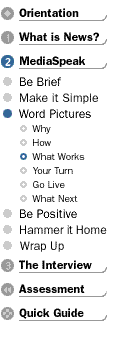The controversy surrounding the formal/informal roles has suddenly created a flurry of excitement around a post on eLearn Mag. However, I’ve addressed it over at the TogetherLearn site, as it seemed somewhat appropriate to respond from the perspective of a champion of social and informal learning.
In short, I point to the issues covered in the Broken ID series, and say that formal instruction isn’t the greatest thing to champion in it’s current form. It may persist, but hopefully in a far better state than most formal we see today. No one’s championing the demise of formal, but certainly improvement, and in conjunction with informal, not as a single solution.
 When we did a course on speaking to the media (and without an LMS to handle the navigation, so no built-in ‘next button’), we had a scheme that both provided a good default, and allowed self-navigation. We had the elements of each of the 3 modules labeled from a learner perspective (e.g. Show Me, Let Me). And we had a nav bar in the upper left that let you choose where to go. At the bottom of the screen (we erred for scrolling rather than one page to minimize clicks and load times, this was over 10 years ago) were also some options of where to go next, with one indicated as the recommended choice. We graphically supported this with a dotted line leading the learner through the content and to the default choice (follow the bouncing ball).
When we did a course on speaking to the media (and without an LMS to handle the navigation, so no built-in ‘next button’), we had a scheme that both provided a good default, and allowed self-navigation. We had the elements of each of the 3 modules labeled from a learner perspective (e.g. Show Me, Let Me). And we had a nav bar in the upper left that let you choose where to go. At the bottom of the screen (we erred for scrolling rather than one page to minimize clicks and load times, this was over 10 years ago) were also some options of where to go next, with one indicated as the recommended choice. We graphically supported this with a dotted line leading the learner through the content and to the default choice (follow the bouncing ball).